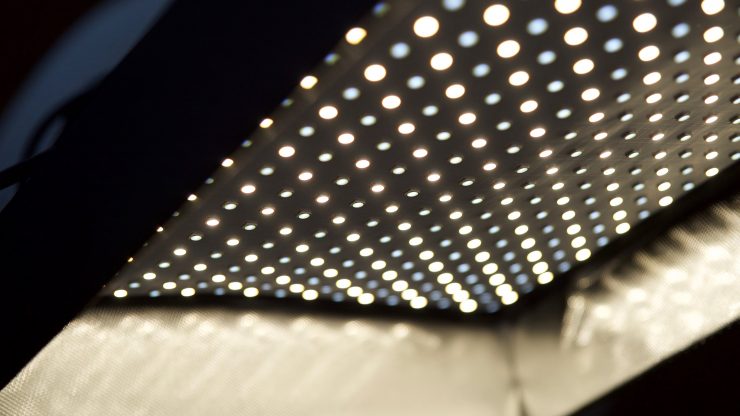
Flexible LED panels were all the rage a few years ago, but now RGB lights have become the latest must-have lighting tool. While RGB lights offer a lot of versatility they are still for the most part, large, heavy, power hungry, and expensive. You may well love the idea of owning an RGB light, but if you sit down and ask yourself “Do I really need one?” the answer is probably going to be no. There is still very much a place for flexible LED lights, particularly for travelling shooters who need to keep gear to a minimum. One of the latest flexible LED light companies is DP Lumi who are making 1×1 and 1×3 sized panels.
For this review, I’m going to focus on the companies 1×3 Bi-color light that is colour adjustable between 3200-5600k.
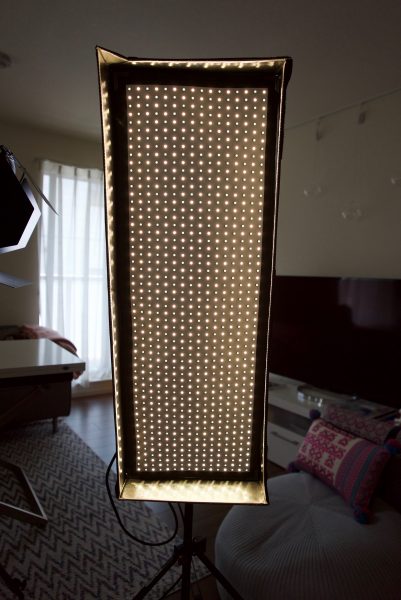
Love hate relationship
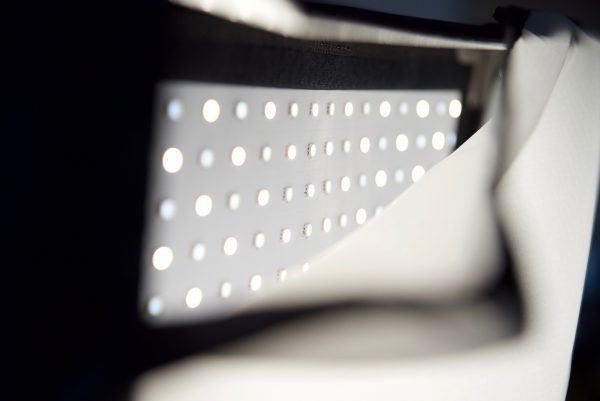
Flexible panel lights are not a new concept, companies such as Westcott and Aladdin have been making them for years, and while they are great to use, a lot of users are put off by their relatively low output compared to a traditional 1×1 panel light. I have been using flexible panel lights for a long time, but recently I have shied away from them in favour of more powerful and quicker to use LED lights. The dilemma for me when using flexible LED is the compromise you have to make. The beauty of flexible LED lights is that they are lightweight and extremely versatile, the downsides are that the power output is limited and they often take a lot of time to set up. I guess you can’t have your cake and eat it too. Well, what if you could? I wanted to find out if DP Lumi’s fixtures could in some way address the complaints I have with flexible LED lights.
Build quality and Mounting bracket
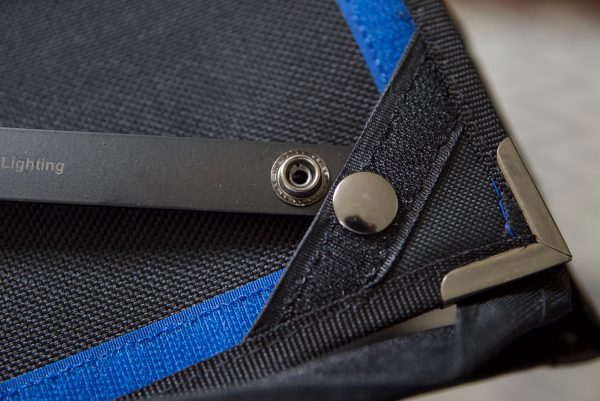
DP Lumi’s lights don’t really look any different from any other flexible LED panel light you may have seen before. Appearance wise the only real difference is the clips on the back of the fixture that secure the mounting frame. Speaking of mounting frames, the amount of badly thought out ones I have used in the past from other manufacturers helped me overflow the swear jar on many occasions. Often these mounting brackets had to be assembled from multiple pieces and in some cases, they ended up breaking within the first few weeks. Look I get it, I know you need some sort of frame to be able to put a flexible LED light on a light stand but why does it have to be so hard to make a decent one?
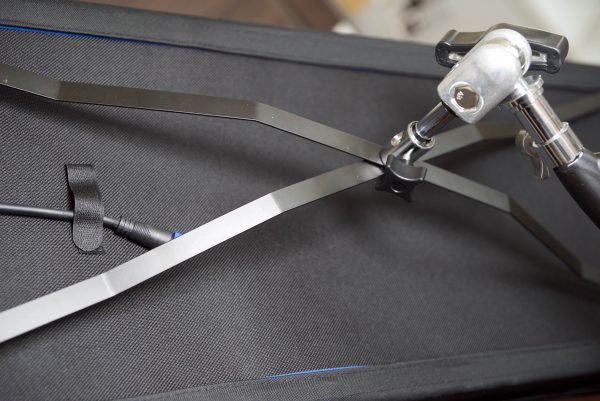
DP Lumi hasn’t made a radical departure from using mounting brackets, but at least they have made one that is a little quicker and easier to set up and attach. The mounting bracket DP Lumi uses is perhaps a little heavier than what you may be used to. It’s also bent in several places so it keeps your light more rigid and flat when it’s attached to the bracket. In a nice touch, there are clips on the end that allow you to securely attach the bracket to the light, so it won’t move or fall off.
The only trouble with the mounting bracket for the 1×3 is that it’s long and it won’t fit in a lot of bags. It does, however, fit in the included bag that DP Lumi gives you, but if you choose not to use that bag you may well find it hard to transport.
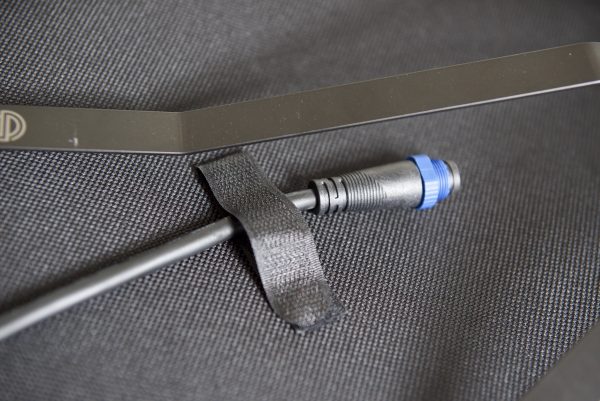
DP Lumi has paid a lot of attention to detail. The connectors are well made, the cables are nice and long, and there is even a nice piece of velcro that enables you to safely secure the power connector that goes from the dimmer/ power supply box to the light. These may sound like small things, but they make a big difference when you are using the light.
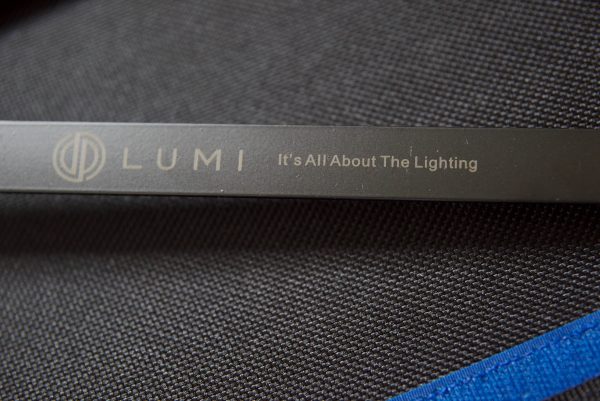
The light is really well made and the materials used are a lot better than most other flexible LED lights I have seen. It really does seem like a more robust professional solution that has been designed to stand up to the rigours of field use.
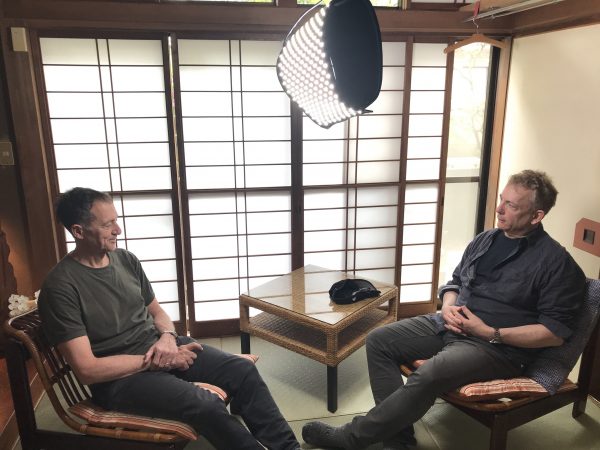
One of the clever things DP Lumi has done when designing the light is put velcro on one edge so you can fold the light around and secure it so it forms a circle. This is nice if you want to use the light as a sort of china ball or to evenly illuminate two people in a sit-down interview scenario. For travelling shooters, this versatility is what makes flexible LED panel lights such a compelling option.
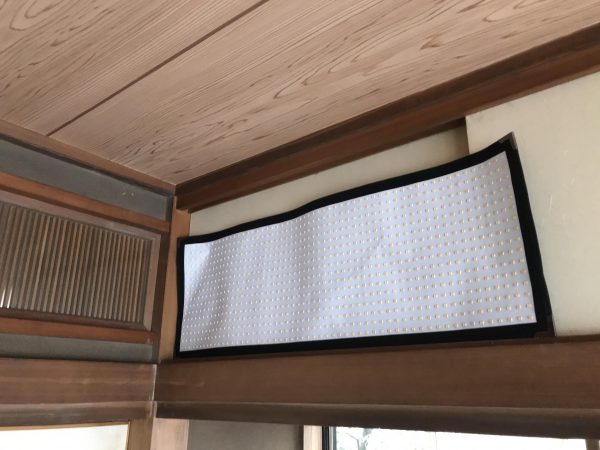
The only thing I would have liked to have seen included on the DP Lumi lights is eye holes on the corners. Having eye holes increases your mounting options and allows you to use a simple piece of string or rope to attach the light.
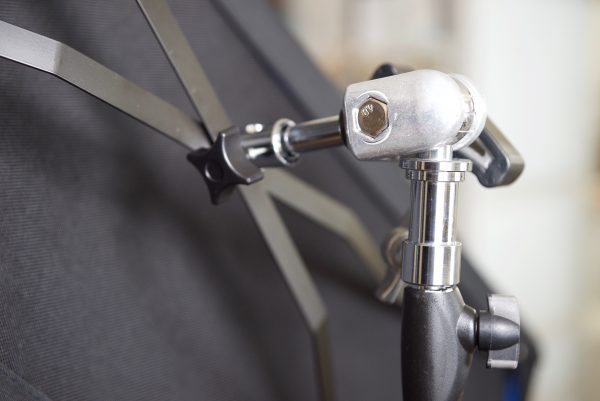
The company also includes a heavy-duty ball mount that looks like it was designed to support a fixture weighing 10x as much. Maybe it’s a case of overkill, but at least you will know with absolute certainty that it will support the light in any position. This Heavy Duty 5/8 Swivel Pin adds articulation to your light stand giving you the option to turn your lights horizontally, vertically or facing up and down. One end slips onto a male 5/8″ pin while the other supports our light panels with a 5/8″ receiver. The ball joint allows 180° swivel of the fixture, while the large, rubber-covered T-handle provides secure locking in your chosen position. The barrel at the receiver end measures 1 1/8″. Removing the tightening knob from it allows you to drop it into a 1 1/8″ receiver.
Power supply/dimmer unit
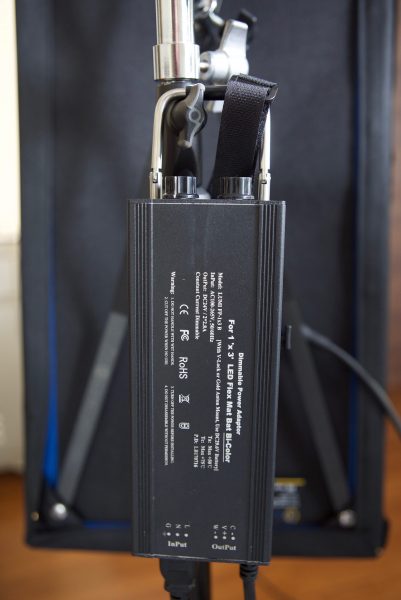
1×2 or 1×3 flexible panel lights usually come with quite a large dimmer/power supply units, and the DP Lumi is no exception. The 1×3’s dimmer/power supply unit weighs in at a rather heavy 1.6kg (3.52lb). There is no doubt that it’s well made, but in some ways, you have to wonder if this weight is counter-intuitive when using a lightweight flexible LED panel. I mean isn’t the whole idea of using a flexible LED light that it’s supposed to be lightweight?
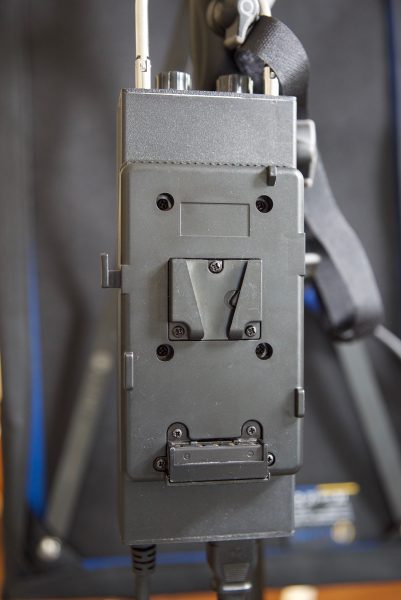
The power supply/dimmer unit has a nice handle that you can use to attach to a light stand, as well as a velcro strap for added security. On the top, there is a v-lock or AB Gold Mount battery plate depending on what option you choose.
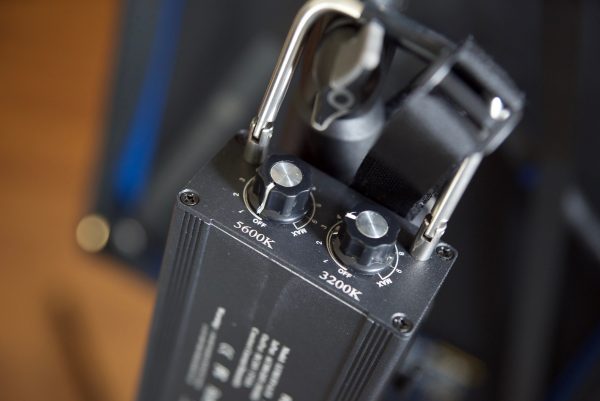
On the front, there are two control dials, one labelled 5600K and the other 3200K. The way this work is perhaps a little different to controls on LED lights that you may be used to. Both the 5600K and 3200K dials increase the brightness of the light. For example, if you turn up the 5600K dial all your are doing is turning up the brightness and keeping the colour temperature at 5600k. If you turn up the 3200K dial you are increasing the brightness of the 3200K LEDs. If you turn up both the 3200K and 5600K dials you end up changing the colour temperature as well as increasing the brightness.
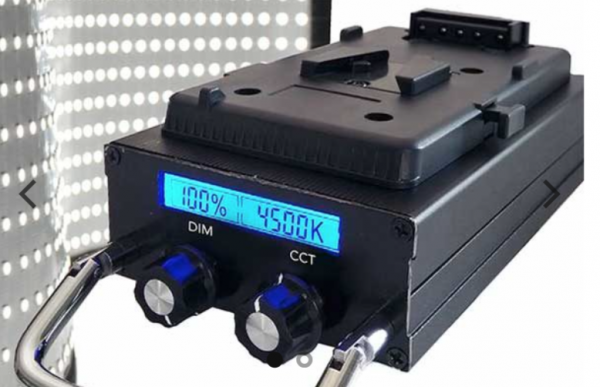
While I don’t mind how this is done, it is a little confusing as to what Kelvin colour temperature you are producing when you turn on both the 3200K and 5600K LEDs. On the new dimmer/power supply units that will be available in July, this will all change and you will be able to see the actual kelvin colour temperature displayed on an LCD screen.
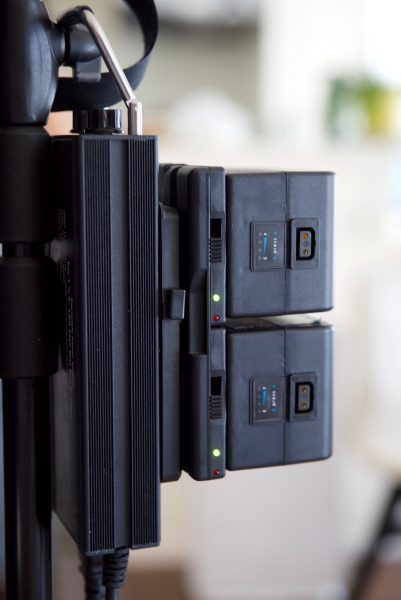
The dimmer/power supply unit I was reviewing requires a 160Wh battery to run the fixture. There isn’t a lot of choices when it comes to 160Wh batteries. I would have preferred to have seen a system that only required 150Wh batteries. To power the light I used two Hawkwoods 150Wh Mini V-Lok batteries on a Hawkwoods Mini V-Lok Dual battery plate. I found from my testing that the light performed as advertised when running off camera batteries.
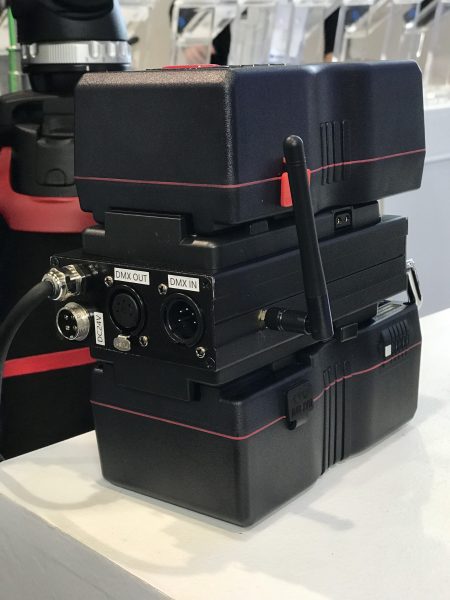
A new generation 2 dimmer/power supply unit is coming in July and it will have the following features:
– new mounting options
1×3 size
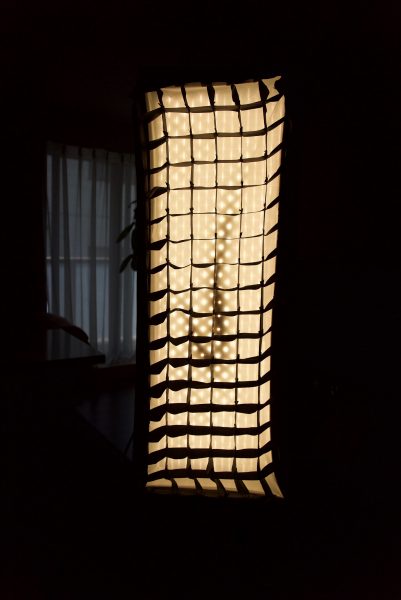
1×3 sized lights are not overly common, a lot of fixtures come in the more traditional 1×1 and 2×1 sized form. I actually like the 1×3 size as it allows you to light both vertically and horizontally depending on what you are doing. By putting the light in a vertical position you can light someone from head to toe if they happen to be standing, and conversely, if you have two people sitting side by side if you use the light horizontally it will have enough coverage to light both subjects.
Photometrics
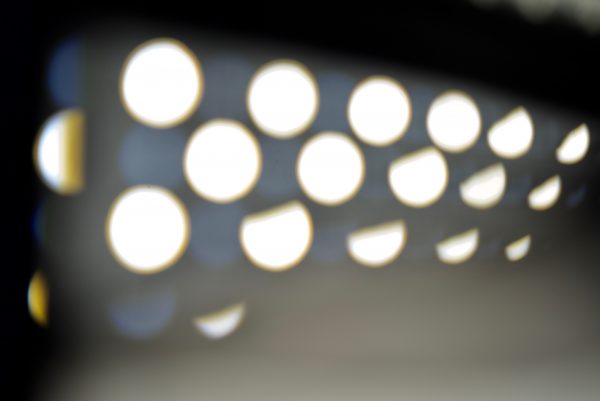
So now let’s get to the photometric results. I always test lights in this way so that I get a reference to how they compare to other fixtures. Results only tell part of the story and should never be used alone to judge a light. I have found from extensive testing over the years that certain lights that have good photometric results don’t always look good, and lights that have worse photometric scores can sometimes look better than their results indicate.
OUTPUT AND KELVIN COLOUR TEMPERATURE ACCURACY
I tested the 1×3 Bi-Color at a variety of Kelvin colour temperatures with a Sekonic C-700 Spectrometer to find out how much output the light had and how accurate the Kelvin colour temperature reproduction was. All readings are taken at a distance of 1m (3.28ft) in a controlled environment.
3200K
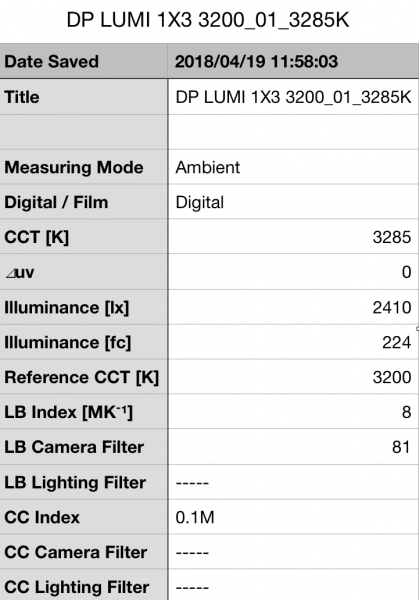
4400K
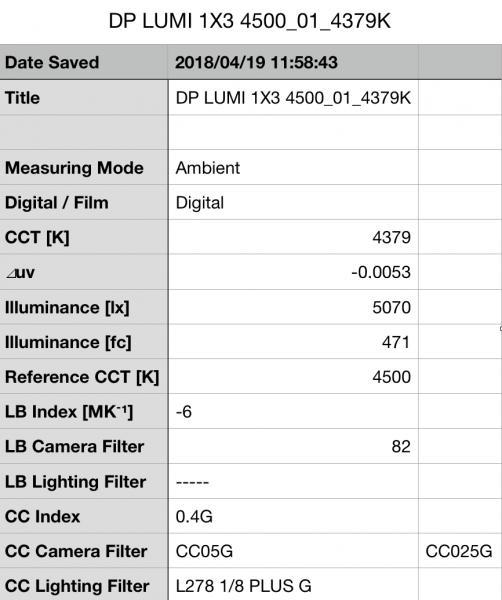
5600K

As you can see from the above readings the light recorded an output of 2410lx (224fc) when set at 3200K, 5070lx (471fc) when set at 4400K, and 2830lx (263fc) when set at 5600K. Now, these numbers are hardly earth-shattering and I found that the output varies dramatically depending on the colour temperature you have the light set at. As the fixture uses two different sets of LEDs, the output when both the 3200K and 5600K LEDs are active is around double that of when the fixture is used at either 3200K or 5600K. This is hardly ideal as most users won’t want to set the light to 4400K just to get a high output. The output of this light is fairly average at 3200K or 5600K considering its large size. The companies 1×1 Daylight flexible LED light outputs 2160lx (201fc) at 5600K.
You do have to take into account that these figures were recorded with the current dimmer/power supply. DP Lumi claims that the new dimmer/power supply that will run off two 14.4V camera batteries will output a claimed 6500 lux at a distance of 1m. I do, however, believe that this figure will only be possible at the 4400K setting.
Let’s have a look at how the DP Lumi’s output compares to some other 2×1 flexible LED panels (I haven’t tested any other 1×3 panels, hence the comparison against 2×1 fixtures):
Aladdin Bi-Flex 2×1 (5600K)
3650lx (339fc)
Westcott 2×1 Flex Bi-Color (5600K)
3250lx (302fc)
Aladdin Bi-Flex 2×1 (3000K)
2950lx (274fc)
Westcott 2×1 Flex Bi-Color (3200K)
3040lx (282fc)
As you can see both the smaller Aladdin Bi-Flex 2×1 and Westcott 2×1 Flex Bi-Color both have higher outputs than the DP Lumi. The only time the DP Lumi produces more output is when it is set a 4400K and both sets of its LED’s are turned on.
As far as Kelvin colour accuracy goes, when set at 3200K the light gave me a figure of 3285K. When set at 4400K it gave me a figure of 4379K, and when set at 5600K I got a figure of 5905K. These figures were all pretty good, although the reading at 5600K was more than 300K off.
Colour Rendering
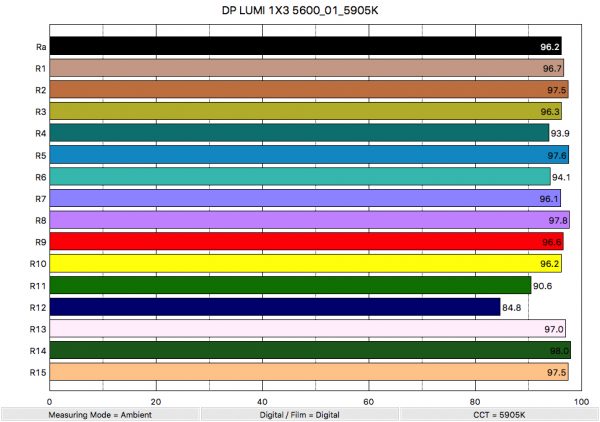
So now that we have seen how much output the DP Lumi 1×3 produces, how does it perform when it comes to replicating accurate colours. Above you can see that when the light was set at 5600K it recorded an average CRI (R1-R8) of 96.2 and an extended CRI (R1-R15) of 95.38. For replicating accurate skin tones it recorded 96.6 for R9 (red), 97.0 for R13 (closest to caucasian skin tones), and 97.5 for R15 (closest to Asian skin tones). These results were very good.
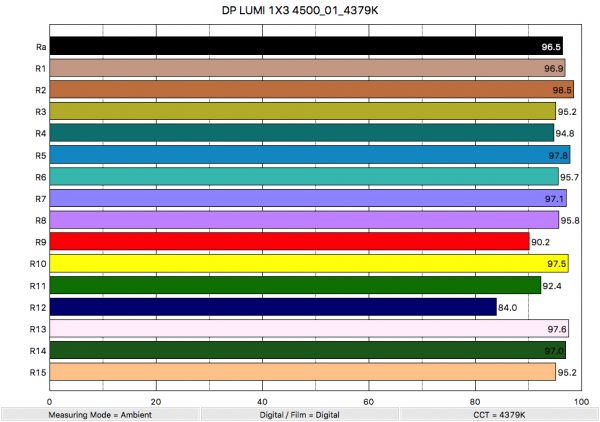
Above you can see that when the light was set at 4500K it recorded an average CRI (R1-R8) of 96.5 and an extended CRI (R1-R15) of 95.04. For replicating accurate skin tones it recorded 90.2 for R9 (red), 97.6 for R13 (closest to caucasian skin tones), and 95.2 for R15 (closest to Asian skin tones). These results were again very good, and very comparable to when the light was set at 5600K.
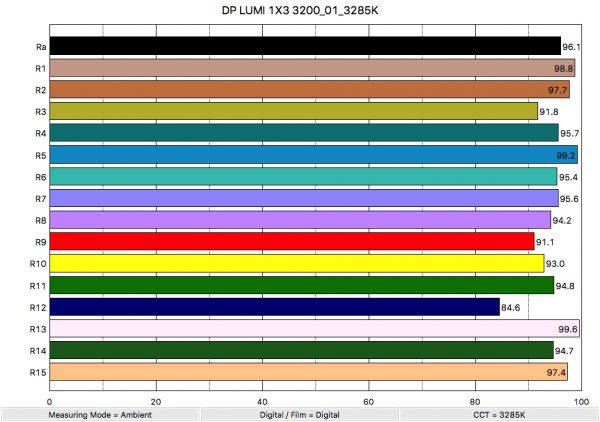
Above you can see that when the light was set at 3200K it recorded an average CRI (R1-R8) of 96.1 and an extended CRI (R1-R15) of 94.90. For replicating accurate skin tones it recorded 91.1 for R9 (red), 99.6 for R13 (closest to caucasian skin tones), and 97.4 for R15 (closest to Asian skin tones).
From my testing, it is safe to say that the DP Lumi 1×3 is very consistent across its Kelvin colour temperature range when it comes to accurate colour rendering. The results I recorded were all very high and up there with some of the best LED lights I have tested.
In comparison lets look at what average CRI (R1-R8) and extended CRI (R1-R15) readings some other 2×1 Bi-Color flexible lights recorded:
Aladdin Bi-Flex 2×1 (5600K)
average CRI (R1-R8) 97.0
extended CRI (R1-R15) 95.52
Westcott 2×1 Flex Bi-Color (5600K)
average CRI (R1-R8) 97.0
extended CRI (R1-R15) 95.2
Aladdin Bi-Flex 2×1 (3000K)
average CRI (R1-R8) 98.5
extended CRI (R1-R15) 97.54
Westcott 2×1 Flex Bi-Color (3200K)
average CRI (R1-R8) 96.9
extended CRI (R1-R15) 95.45
Spectral Distribution
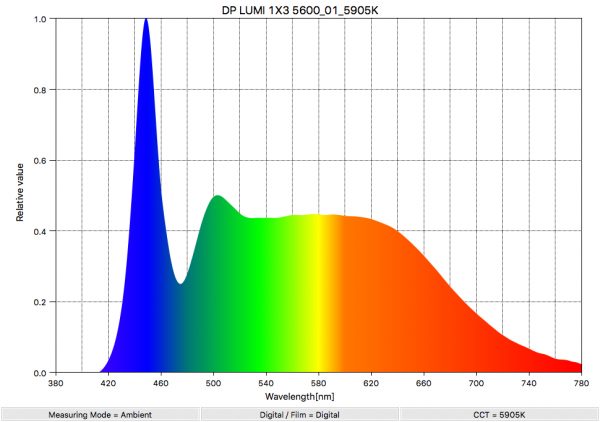
Above you can see the spectral distribution of the DP Lumi 1×3 when it is set at 5600K. The spectral distribution is pretty good at 5600K and the light only has a marginal green spike. Despite having a nice even spectrum, for the most part, the light is missing quite a bit of information around the 480nm wavelength.
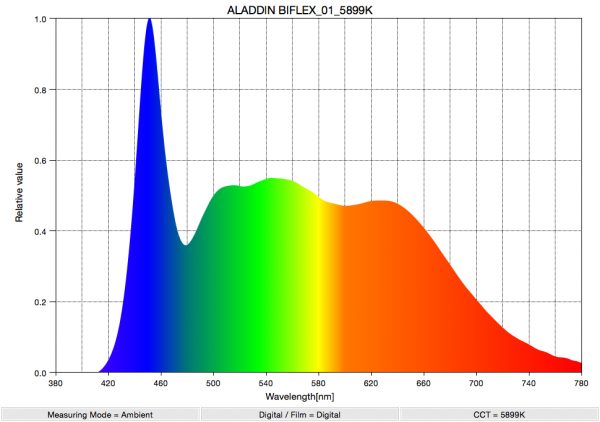
Lets now compare that against the very good Aladdin Bi-Flex 2×1. Above you can see the spectral distribution when that light is set at 5600K. As you can see the Aladdin has a much fuller colour spectrum and doesn’t have a big gap at around 480nm.
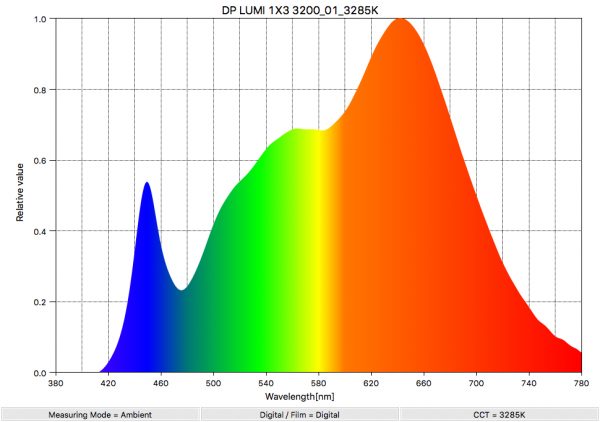
Above you can see the spectral distribution of the DP Lumi 1×3 when it is set at 3200K. The spectral distribution is pretty good at 3200K, but the light certainly has a bit of a push towards green.
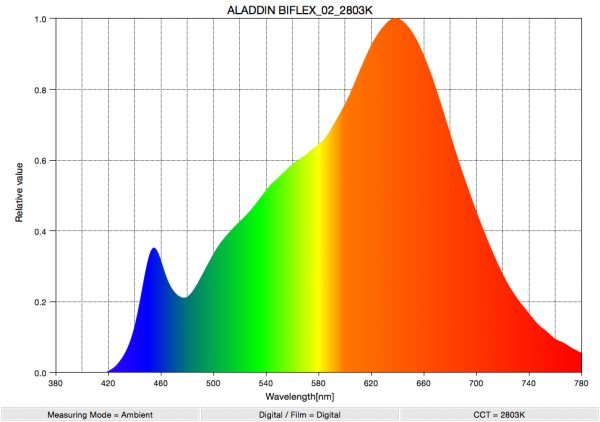
Again lets now compare that against the Aladdin Bi-Flex 2×1. Above you can see the spectral distribution when that light is set at 3000K. As you can see the Aladdin has a much more linear spectral distribution despite the DP Lumi having a slightly fuller spectrum.
Real-world performance
While it’s important to test a lights photometrics, graphs and figures can only tell you part of the story. Just because a light performs well when it comes to photometrics, there is no guarantee that those results transfer over to a nice quality of light.
Despite the DP Lumi 1×3 only having a fairly average output, its large size means it does generate a nice even soft source of light. I have always found that 2×1 or 3×1 sized fixtures are able to wrap light around a subject because of their physical width. Now, this does mean that you get a lot of light spill and if you aren’t after that look you do need to use the egg crate.
Above you can see a couple of quick shots I did with the light at both 5600K and 3200K. I used both the softbox with diffusion and the egg crate. A DP Lumi 1×1 daylight was used as a backlight. There is no fill light being used. You can see the benefit of using a wide 1×3 sized light for an interview setting like this. Because of that added width when using the light horizontally it wraps around the face more and you don’t get harsh shadows. This makes it easier to get away with using just two lights if you are a travelling cameraman.
The light really needs to be used with the diffusion and softbox if your talent is going to be looking towards it. Without the diffusion, the individual point sources from all the LEDs makes looking at the light very uncomfortable.
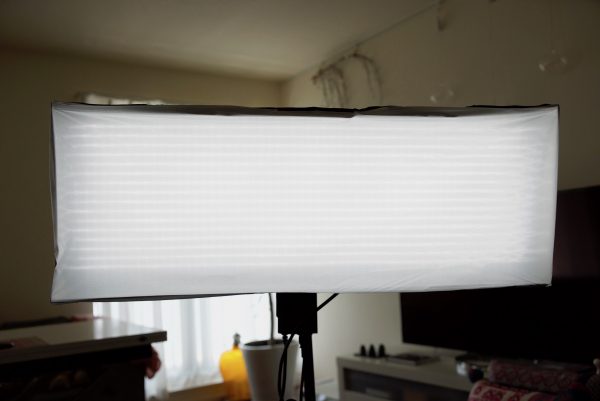
Speaking of the softbox, it’s well made and easy to assemble. The diffusion is also really nice and allows the light to be used as a soft source. You do have to take into account that when using the diffusion the output gets knocked down, so the fixture can’t be too far away from your talent. The light also comes with two different egg crates. One attaches directly to the light and other one attaches to the softbox. It’s nice to be able to use egg crates both with and without the need for a softbox.
I liked the results I got from the DP Lumi, I just wish the fixture was a little brighter. This is just my personal opinion, but if I’m going to carry around a fixture of this size (regardless of whether it is flexible or not) it really does need to produce a certain amount of output.
In saying that, I found the biggest strength of the 1×3 was its versatility. Being able to use one fixture for a variety of lighting scenarios is always a good thing. Being able to fold it, stick it on a wall, hang it out on a boom arm, or use it as a china ball is something you can’t do with most other lights (well at least not easily).
Value for money
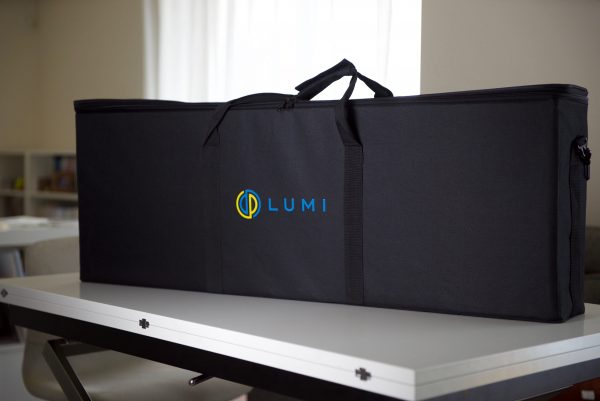
Price certainly isn’t an indication of quality when it comes to the DP Lumi 1×3. In fact, it’s hard to argue that the 1×3 flexible panel light doesn’t represent excellent value for money. For $1,275 USD DP Lumi gives you a carry bag, V-mount or AB Gold Mount driver, softbox, egg crate and X-Bracket with Pro 5/8″ stud hardware for mounting. In comparison, the Westcott Flex Daylight LED Mat (1 x 3′) is currently available for $1399 USD (reduced from $1699 USD), but it only comes with a dimmer/power supply unit and nothing else.
Conclusion
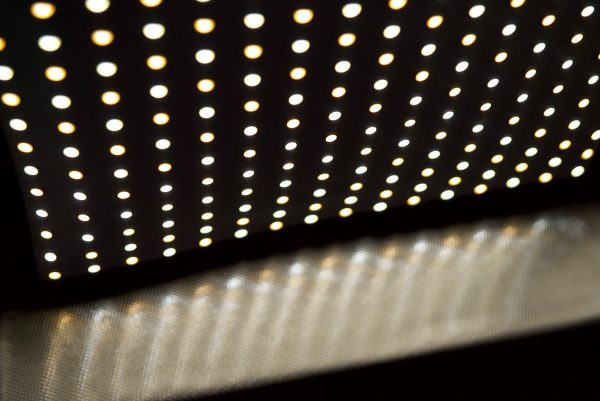
DP Lumi has done a good job with their 1×3 flexible LED light. While it may not be as bright as some of the other competing fixtures, it has been well thought out and it’s solidly made. It’s the first flexible LED light I’ve seen that looks like it has been designed for the rigours of field use. The fact that the company gives you a ton of accessories and a bag to transport the light in tells me a lot. Too often companies just give you a light and nothing else. On the surface, these lights look like a good deal, but once you factor in how much you have to spend on additional accessories then it really starts to add up. This is something you don’t have to worry about with DP Lumi lights.
My only real gripe with the light is when it comes to output, but hopefully, the new dimmer/power supply unit that is coming in July will go some way to addressing that. In my personal opinion, if I’m going to use a large-sized fixture (even a flexible one) it needs to have a decent output.
Is the DP Lumi 1×3 the perfect light, no, but then again what light is. For a relatively small company, they have managed to create a product that is right up there with the more established competition. The DP Lumi 1×3 offers excellent value for money if you are looking for a colour accurate flexible LED light. At $1275 USD with all the added accessories, it’s around the same price as a lot of 1×1 panel lights on the market.
Do you use flexible LED lights? If so, which ones do you use and what has your experience been? Let us know in the comments section below.





